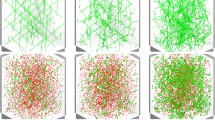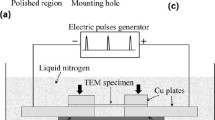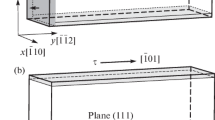Abstract
Laser shock peening is one of the most effective surface strengthening techniques, which uses laser shock-induced plastic deformation to optimize surface stress state and microstructures of target material. In this paper, dislocation dynamics simulation was used to investigate laser shock induced ultra-high strain rate plastic deformation of face-centered cubic (FCC) nickel and body-centered cubic (BCC) iron. Molecular dynamics was employed to calculate dislocation mobility. Based on the obtained dislocation mobility coefficient, dislocation dynamics models of nickel and iron were established. Results show that the velocity of dislocation motion increases as temperature decreases. Under ultra-high strain rate deformation, dislocation density of nickel increases while dislocation density of iron decreases as temperature rises. Moreover, iron exhibits thermal softening while nickel exhibits thermal hardening under laser shock loading. Plastic deformation dominated by dislocations is sensitive to loading direction, depending on the Schmidt factor of the slip system. The ultra-high strain rate induced by laser shock can effectively increase dislocation density by promoting dislocation multiplication and suppressing dislocation annihilation.













Similar content being viewed by others
References
Peyre P, Fabbro R, Merrien P et al (1996) Laser shock processing of aluminium alloys. Application to high cycle fatigue behaviour. Mater Sci Eng A 210(1–2):102–113
Sanchez-Santana U, Rubio-Gonzalez C, Gomez-Rosas G et al (2006) Wear and friction of 6061-T6 aluminum alloy treated by laser shock processing. Wear 260(7–8):847–854
Ebrahimi M, Amini S, Mahdavi SM (2017) The investigation of laser shock peening effects on corrosion and hardness properties of ANSI 316L stainless steel. Int J Adv Manuf Technol 88(5–8):1557–1565
Zepeda-Ruiz LA, Stukowski A, Oppelstrup T et al (2017) Probing the limits of metal plasticity with molecular dynamics simulations. Nature 550(7677):492
Bisht A, Neogi A, Mitra N et al (2019) Investigation of the elastically shock-compressed region and elastic–plastic shock transition in single-crystalline copper to understand the dislocation nucleation mechanism under shock compression. Shock Waves:1–15
Kattoura M, Shehadeh MA (2014) On the ultra-high-strain rate shock deformation in copper single crystals: multiscale dislocation dynamics simulations. Philos Mag Lett 94(7):415–423
Shehadeh MA (2012) Multiscale dislocation dynamics simulations of shock-induced plasticity in small volumes. Philos Mag 92(10):1173–1197
Shehadeh MA, Zbib HM (2016) On the homogeneous nucleation and propagation of dislocations under shock compression. Philos Mag 96(26):2752–2778
Liu ZL, You XC, Zhuang Z (2008) A mesoscale investigation of strain rate effect on dynamic deformation of single-crystal copper. Int J Solids Struct 45(13):3674–3687
El Ters P, Shehadeh MA (2019) Modeling the temperature and high strain rate sensitivity in BCC iron: atomistically informed multiscale dislocation dynamics simulations. Int J Plast 112:257–277
Hu J, Liu Z, Chen K et al (2017) Investigations of shock-induced deformation and dislocation mechanism by a multiscale discrete dislocation plasticity model. Comput Mater Sci 131:78–85
Zhou W, Ren X, Ren Y et al (2017) Initial dislocation density effect on strain hardening in FCC aluminium alloy under laser shock peening. Philos Mag 97(12):917–929
Liao Y, Ye C, Gao H et al (2011) Dislocation pinning effects induced by nano-precipitates during warm laser shock peening: dislocation dynamic simulation and experiments. J Appl Phys 110(2):023518
Liao Y, Cheng GJ (2013) Controlled precipitation by thermal engineered laser shock peening and its effect on dislocation pinning: multiscale dislocation dynamics simulation and experiments. Acta Mater 61(6):1957–1967
Ye C, Liao Y, Suslov S et al (2014) Ultrahigh dense and gradient nano-precipitates generated by warm laser shock peening for combination of high strength and ductility. Mater Sci Eng A 609:195–203
Chang J, Cai W, Bulatov VV et al (2002) Molecular dynamics simulations of motion of edge and screw dislocations in a metal. Comput Mater Sci 23(1–4):111–115
Gilbert MR, Queyreau S, Marian J (2011) Stress and temperature dependence of screw dislocation mobility in α-Fe by molecular dynamics. Phys Rev B 84(17):174103
Olmsted DL, Hector LG Jr, Curtin WA et al (2005) Atomistic simulations of dislocation mobility in Al, Ni and Al/Mg alloys. Model Simul Mater Sci Eng 13(3):371
Branício PS, Rino JP (2000) Large deformation and amorphization of Ni nanowires under uniaxial strain: a molecular dynamics study. Phys Rev B 62(24):16950
Mendelev MI, Han S, Srolovitz DJ et al (2003) Development of new interatomic potentials appropriate for crystalline and liquid iron. Philos Mag 83(35):3977–3994
Stukowski A (2009) Visualization and analysis of atomistic simulation data with OVITO–the open visualization tool. Model Simul Mater Sci Eng 18(1):015012
Bulatov VV, Hsiung LL, Tang M, Arsenlis A, Bartelt MC, Cai W, Florando JN, Hiratani M, Rhee M, Hommes G, Pierce TG, de la Rubia TD (2006) Dislocation multi-junctions and strain hardening. Nature 440(7088):1174–1178
Arsenlis A, Cai W, Tang M et al (2007) Enabling strain hardening simulations with dislocation dynamics. Model Simul Mater Sci Eng 15(6):553
Bulatov V, Cai W, Fier J, et al. (2004) Scalable line dynamics in ParaDiS[C]//Supercomputing, 2004. Proceedings of the ACM/IEEE SC2004 Conference. IEEE: 19
Greer JR, Weinberger CR, Cai W (2008) Comparing the strength of f.c.c. and b.c.c. sub-micrometer pillars: compression experiments and dislocation dynamics simulations. Mater Sci Eng A 493(1–2):21–25
Po G, Cui Y, Rivera D et al (2016) A phenomenological dislocation mobility law for bcc metals. Acta Mater 119:123–135
Zaretsky EB, Kanel GI (2012) Effect of temperature, strain, and strain rate on the flow stress of aluminum under shock-wave compression. J Appl Phys 112(7):073504
Fan Z, Xiuguang H, Hua S et al (2015) High-power laser shock-induced dynamic fracture of aluminum and microscopic observation of samples[C]//EPJ Web of Conferences. EDP Sci 94:02008
Gurrutxaga-Lerma B, Shehadeh MA, Balint DS et al (2017) The effect of temperature on the elastic precursor decay in shock loaded FCC aluminium and BCC iron. Int J Plast 96:135–155
Anderson PM, Hirth JP, Lothe J (2017) Theory of dislocations. Cambridge University Press, Cambridge
Wang ZQ, Beyerlein IJ, LeSar R (2009) Plastic anisotropy in fcc single crystals in high rate deformation. Int J Plast 25(1):26–48
Hosseinzadeh DA (2015) Numerical modeling of plasticity in FCC crystalline materials using discrete dislocation dynamics. KTH Royal Institute of Technology, Stockholm
Cui YN, Lin P, Liu ZL et al (2014) Theoretical and numerical investigations of single arm dislocation source controlled plastic flow in FCC micropillars. Int J Plast 55:279–292
El-Awady JA (2015) Unravelling the physics of size-dependent dislocation-mediated plasticity. Nat Commun 6:5926
Funding
The authors are grateful to the projects supported by the National Natural Science Foundation of China (Grant No. 51975261), the Natural Science Foundation of Jiangsu Province (Grant No. BK20160014), and the Innovation Team of Six Talents Peaks in Jiangsu Province (Grant No. 2019TD-KTHY-005).
Author information
Authors and Affiliations
Corresponding author
Additional information
Publisher’s note
Springer Nature remains neutral with regard to jurisdictional claims in published maps and institutional affiliations.
Rights and permissions
About this article
Cite this article
Zhou, W., Ren, X., Yang, Y. et al. Dislocation behavior in nickel and iron during laser shock-induced plastic deformation. Int J Adv Manuf Technol 108, 1073–1083 (2020). https://doi.org/10.1007/s00170-019-04822-8
Received:
Accepted:
Published:
Issue Date:
DOI: https://doi.org/10.1007/s00170-019-04822-8




